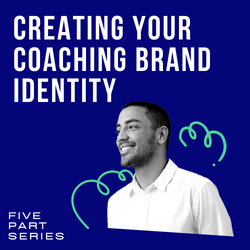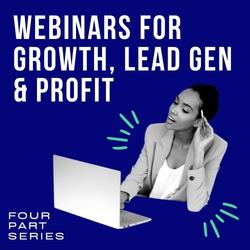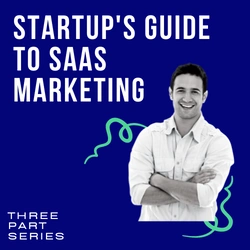A SERVERWISE THREE PART SERIES
The Startup's Guide To SaaS Marketing: 3 Step Simplified Sales And Lead Funnel
This article is for those first starting out with little to no experience in sales and lead generating funnels. I’m intentionally keeping the information simple, as I believe everyone needs a firm foundation to excel.
3-Step Simplified SaaS Sales Flow
Step 1: Connect and Qualify
Step 2: Needs Assessment and Close
Step 3: Follow Up and Close
What I’m teaching in this article would be considered 101 level knowledge. But I’ve worked with too many clients recently who simply do not have a strong foundation in the basics. After all, without that rudimentary understanding, you can’t rocket your SaaS business to the next level or switch to a more advanced marketing strategy.
I’m going to take you through a simple sales process to demystify it and build your confidence as a business owner focused on growth marketing.
Step 1: Connect and Qualify
The first step in sales is a two-part process; Connect and Qualify.
You have a great product or service that you’re excited to tell the world about, but first you need to connect with people, and then you must qualify them or determine if they are a potential customer.
In marketing, we also call this targeting your buyer persona, but for the purposes of learning the fundamentals, we’re going to refer to it as Connect and Qualify.
Connecting is easy. You pull in the potential customer and ask a basic question to determine their overall interest.
As an example, let’s assume your SaaS is a new style of educational math and science tutorial for children ages 7 to 12.
In person, you would introduce yourself (connect) and ask if the individual has children (qualify). If the answer is yes, you now would ask the age or ages of the children. This is designed to help you determine whether the potential customer meets your basic customer demographic.
In the digital world, you would accomplish this with a quick piece of content, Google or Facebook Ad or social media post. In fact, a headline that asks the same basic question is all it takes.
But Why Exactly Ask That Question?
Too many entrepreneurs waste their time talking to people who will not become customers. Your time is important, so make the connection and immediately seek to qualify the potential lead. If the lead isn’t qualified, move on.
In the educational SaaS example, you would want to dive deeper into the qualification of the parent. You identified that the individual has a child in your service range, but what if that child doesn’t need tutoring? Maybe that child is a math and science whiz kid? So, you’re going to want to ask a couple follow-up questions.
- Is your son/daughter struggling in math or science?
- Does your child excel using less traditional learning formats?
- Is your kid frustrated trying to keep up in science class?
You need to identity to what level your new connection qualifies for your product or service. If the student is a B+ student and the parent and child are content with that – move on.
This type of lead qualifier can be easily included in your digital marketing (Facebook posts and ads, a quick YouTube video ad, etc.) using a simple quiz format that people find hard to ignore.
That’s the Qualify part.
Just as you would seek to maximize your time management when talking to possible customers in person, you would want to optimize and maximize your digital ad costs as well by weeding out those that are not a good fit for your service.
Step 2: Needs Assessment and Close
The second step is also in two parts. First you assess the needs of the potential customer (the lead) and then you close the sale. In marketing speak, we would refer to this as converting the lead.
A good salesperson knows that customizing the offer is the fastest way to close the sale. Now you can’t do that unless you know exactly what their needs are, which is where the needs assessment comes in.
The way you customize your offer or your pitch is to try to understand what that customer needs the most that you can offer. What are their specific concerns, pain points, requirements or even frequency of use?
To do this, you’ll want to ask exploratory questions. In our example, those questions may be:
- Is your kid more of a visual learner?
- Do you frequently find yourself arguing with your child about homework?
- Have you noticed any emotional outbursts from your son/daughter when they’re trying to learn math?
- Has your child ever called him/herself stupid because the subject doesn’t come easy to them?
You use these questions to feel out the individual and gain some insight into the specific issues (pain points) that they’re experiencing. Once you figure out their specific situation, you can customize your message to alleviate their concerns and prove that you do, in fact, have a viable solution for them.
But how do you take this knowledge and use it in the digital marketing landscape? Easier than you may think.
Those questions above are all viable Facebook post and ad headlines. And they would do just as well in Instagram ads or YouTube. Those questions establish the need of the audience. After all, if you have a child who isn’t struggling, you wouldn’t think twice about that headline on a Facebook ad or post.
Once you’ve assessed the needs of the potential customer (lead) you can move to close by sharing your guarantee and the price.
Step 3: Follow Up and Close
At least 70% of the time, the individual who is interested in your service and fits your qualifications isn’t ready to decide immediately. Sometimes they’ll tell you that they need to talk it over with their business partner or spouse. Online it’s usually because they’re going to do some research, look up your business and read reviews or take some time browsing your content on your social media pages. Either way, this is where the all-important follow-up takes over.
In person, you would follow up by setting a meeting. Successful salespeople call this BAMFAM or Book A Meeting From A Meeting.
Your lead needs to connect with someone else to review the decision. Perhaps he or she said something like “Let me discuss this with _____, and I’ll get back to you”.
Now “Book A Meeting From A Meeting” takes over with, “Great, when do you think you’ll have that meeting “or that conversation?”
Most of the time, the individual (lead) will answer your question with the expected time and day. At which point you would say, “Why don’t we schedule a meeting the exact same time the following day.” You keep it to the exact same time because you already know that time works within their schedule, and you don’t want to start playing the appointment setting game.
“Why don’t we book a quick ten-minute call to reconnect and close the loop on this.”
Taking this same marketing tactic into the digital world is even less time-consuming for a business owner because you’ll be using automated tools.
Instead of a quick call or using the BAMFAM approach, you’ll funnel that potential customer or lead into your funnel where your automated autoresponder will contact them periodically on your behalf and offer up a nudge. You’d include helpful content as well as an enticing promotional offer or two – possibly even a deeply discounted trial period to get them in the door, experiencing your service and get their billing details on record.
Quick Simplified SaaS Sales Funnel Review
To review, you’re going to connect and qualify the individual and make sure the person is in the market for your service. This can be a phone call, email, social media post or digital ad. Secondly, you’re going to assess their needs to determine their specific challenges and problems that your service could solve. This step is easily accomplished with a short online quiz or a few helpful social media posts. And finally, you’re going to follow up to close the sale and score another customer for software-as-a-service or membership site.
While this is the simplified version of the sales and lead generating funnel process, it’s the foundation that every successful marketer requires first starting out. If you follow the simple method in the beginning, you’ll get more customer and close sales, which will provide revenue that will allow you to expand your marketing into growth territory.

Everyone who is selling something could use a strong info-product to compliment their brand and boost engagement. Whether you charge for it upfront or not is irrelevant. I’ve put together my 18 step cheat sheet for creating awesome products. Keep Learning >

One of the biggest assets you’ll ever create is your mailing list. You build trust and authority by sending highly relevant info that your subscribers can act on. Growing your subscribers doesn’t have to be difficult with these seven methods you can start right now. Keep Learning >



